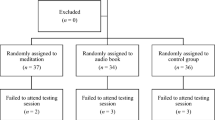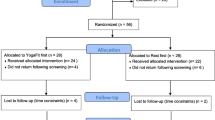Abstract
Thirty-five subjects participated in (1) a pretreatment session during which arousal was measured while subjects anticipated and then viewed a stressful film; (2) four 20-min treatment sessions during which subjects received either contingent EMG biofeedback (biofeedback treatment), instructions to attend to a variable pitch tone (attention-placebo control), instructions to relax as much as possible (instructions-only control), or instructions to sit quietly (no-treatment control); and (3) a posttreatment session that was identical to the pretreatment session. Results indicate that when compared to the subjects in the control conditions, subjects who received EMG biofeedback were not effective in reducing frontalis EMG levels during treatment or while viewing the stressful film, but they were effective in reducing frontalis EMG levels while anticipating the stressful film. There was no evidence that EMG biofeedback influenced either skin conductance or self-reports of arousal.
Similar content being viewed by others
References
Alexander, A. B. An experimental test of assumptions relating to the use of electro-myographic biofeedback as a general relaxation technique.Psychophysiology 1975,12 656–662.
Alexander, A. B., White, P. D., & Wallace, H. M. Training and transfer of training effects in EMG biofeedback assisted muscular relaxation.Psychophysiology 1977,14 551–559.
Budzynski, T. H., & Stoyva, J. M. An instrument for producing deep muscle relaxation by means of analog information feedback.Journal of Applied Behavior Analysis 1969,2 231–237.
Budzynski, T. H., Stoyva, J., & Adler, C. Feedback-induced muscle relaxation: Application to tension headache.Journal of Behavior Therapy and Experimental Psychiatry 1970,1 205–211.
Budzynski, T. H., Stoyva, J. M., Adler, C. S., & Mullaney, D. J. EMG biofeedback and tension headache: A controlled outcome study.Psychosomatic Medicine 1973,35 484–496.
Canter, A., Kondo, C. Y., & Knott, J. R. A comparison of EMG feedback and progressive muscle relaxation training in anxiety neurosis.British Journal of Psychiatry 1975,127 470–477.
Coursey, R. D. Electromyograph feedback as a relaxation technique.Journal of Consulting and Clinical Psychology 1975,43 825–834.
Cox, D. J., Freundlich, A., & Meyer, R. G. Differential effectiveness of electromyograph feedback, verbal relaxation instructions, and medication placebo with tension headaches.Journal of Consulting and Clinical Psychology 1975,43 892–898.
Cronbach, L. J., & Furby, L. How should we measure “change”—or should we?Psychological Bulletin 1970,74 68–80.
DeGood, D. E., & Chisholm, R. C. Multiple response comparison of parietal EEG and frontalis EMG biofeedback.Psychophysiology 1977,14 258–265.
Epstein, L. H., & Blanchard, E. B. Biofeedback, self-control, and self-management.Biofeedback and Self-Regulation 1977,2 201–211.
Friedman, A. P., & Von Storch, T. Tension headaches.Journal of the American Medical Association 1953,151 174–177.
Gatchel, R. J., Korman, M., Weis, C. B., Smith, D., & Clarke, L. A multiple-response evaluation of EMG biofeedback performance during training and stress-induction conditions.Psychophysiology 1978,15 253–258.
Haynes, S. N., Griffin, P., Mooney, D., & Parise, M. Electromyographic biofeedback and relaxation instructions in the treatment of muscle contraction headaches.Behavior Therapy 1975,6 672–678.
Haynes, S. N., Moseley, D., & McGowan, W. T. Relaxation training and biofeedback in the reduction of frontalis muscle tension.Psychophysiology 1975,12 547–552.
Hutchings, D. F., & Reinking, R. H. Tension headaches: What form of therapy is most effective?Biofeedback and Self-Regulation 1976,1 183–190.
Kinsman, R. A., & Staudenmayer, H. Baseline levels in muscle relaxation training.Biofeedback and Self-Regulation 1978,3 97–104.
Kotses, H., Glaus, K. D., Crawford, P. L., Edwards, J. E., & Scherr, M. S. Operant reduction of frontalis EMG activity in the treatment of asthma in children.Journal of Psychosomatic Research 1976,20 453–459.
Lacey, J. The evaluation of autonomic responses: Toward a general solution.Annals of the New York Academy of Sciences 1956,67 123–164.
Malmo, R. B., Shagass, C., & Davis, F. H. Symptom specificity and bodily reactions during psychiatric interview.Psychosomatic Medicine 1950,12 362–376.
Philips, C. The modification of tension headaches pain using EMG biofeedback.Behaviour Research and Therapy 1977,15 119–129.
Raskin, M., Johnson, G., & Rondestvedt, J. Chronic anxiety treated by feedback-induced muscle relaxation.Archives of General Psychiatry 1973,23 263–267.
Reeves, J. L., & Mealiea, W. L. Biofeedback-assisted cue controlled relaxation for the treatment of flight phobias.Journal of Behavior Therapy and Experimental Psychiatry 1975,6 105–109.
Reinking, R. H., & Kohl, M. L. Effects of various forms of relaxation training on physiological and self-report measures of relaxation.Journal of Consulting and Clinical Psychology 1975,43 595–600.
Schandler, S. L., & Grings, W. W. An examination of methods for producing relaxation during short-term laboratory sessions.Behaviour Research and Therapy 1976,14 419–426.
Shedivy, D. I., & Kleinman, K. M. Lack of correlation between frontalis EMG and either neck EMG or verbal ratings of tension.Psychophysiology 1977,14 182–186.
Sime, W. E., & DeGood, D. E. Effect of EMG biofeedback and progressive muscle relaxation training on awareness of frontalis muscle tension.Psychophysiology 1977,14 522–530.
Wickramasekera, I. Instructions and EMG feedback in systematic desensitization: A case report.Behavior Therapy 1972,3 460–465.
Wilder, J. Basimetric approach (law of initial value) to biological rhythms.Annals of the New York Academy of Sciences 1962,98 1211–1220.
Author information
Authors and Affiliations
Additional information
This research was supported in part by Bio-Medical and General Research Fund grants from the University of Kansas to David S. Holmes. Appreciation is due to B. Kent Houston, Edward F. Morrow, and Charles A. Hallenbeck for their contributions to the project.
Rights and permissions
About this article
Cite this article
Nielsen, D.H., Holmes, D.S. Effectiveness of EMG biofeedback training for controlling arousal in subsequent stressful situations. Biofeedback and Self-Regulation 5, 235–248 (1980). https://doi.org/10.1007/BF00998599
Received:
Issue Date:
DOI: https://doi.org/10.1007/BF00998599




